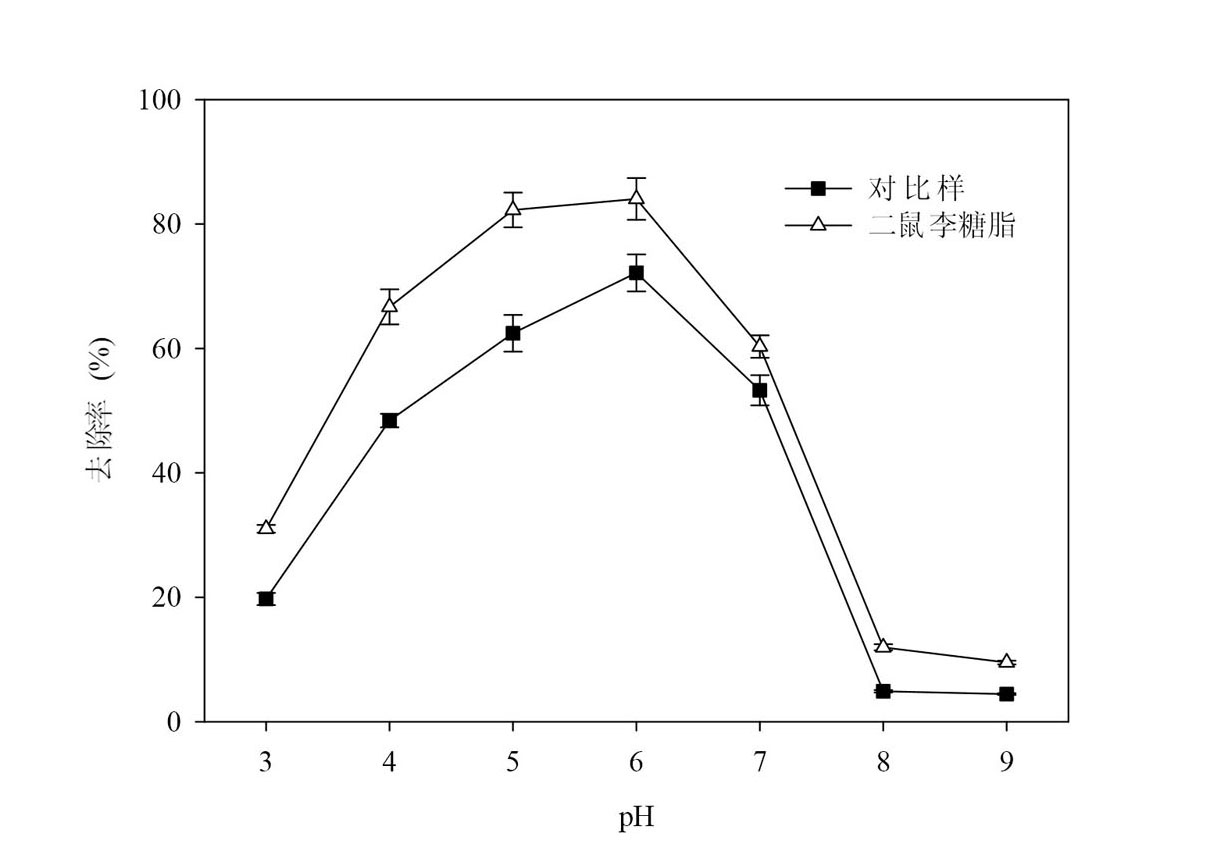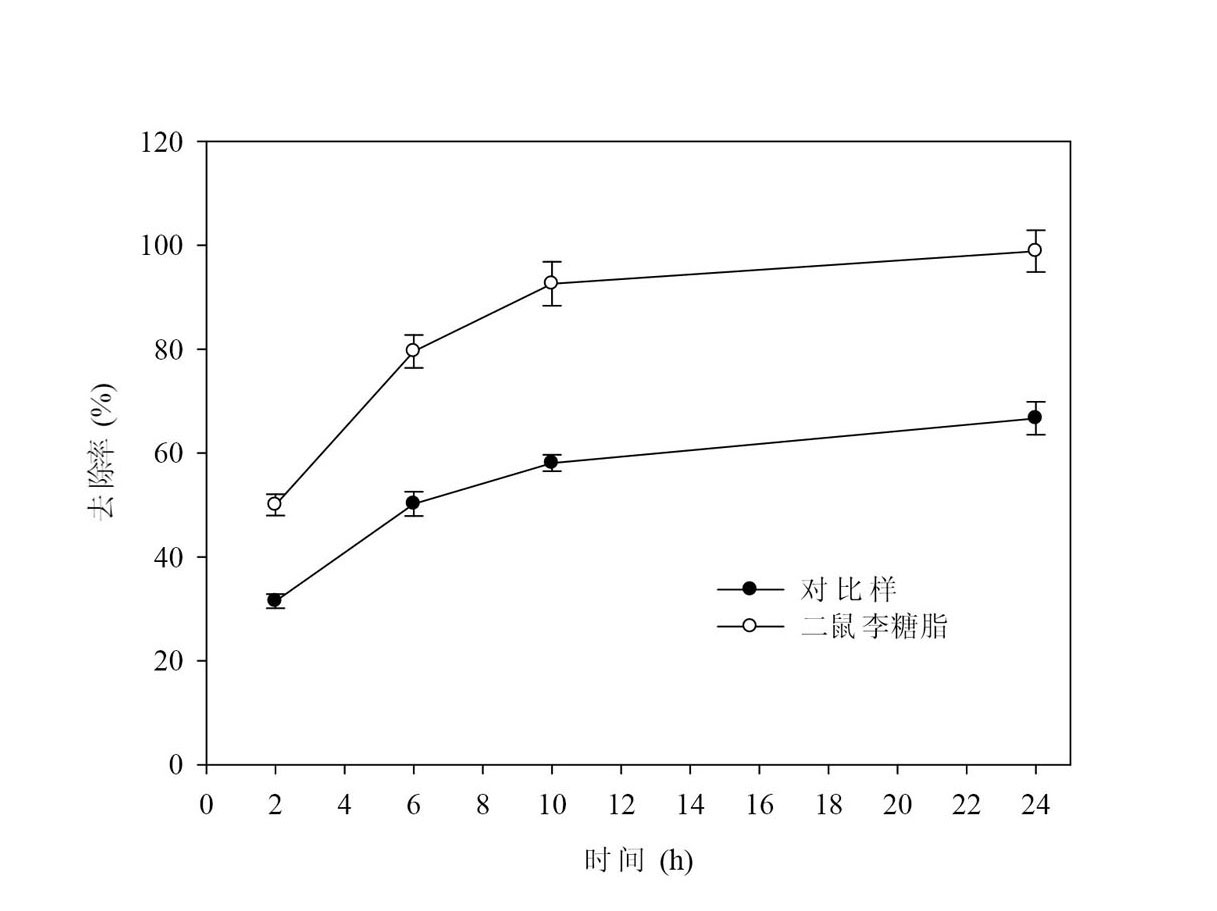Method for removing phenol in waste water by enzyme catalysis
A waste water and phenol technology, applied in chemical instruments and methods, water/sewage treatment, water/sludge/sewage treatment, etc., can solve the problems of environmental secondary pollution, mucous membrane irritation, skin sensitization, etc., and achieve reduction Effects of operating costs, mitigation of passivation, reduction of reaction time
- Summary
- Abstract
- Description
- Claims
- Application Information
AI Technical Summary
Problems solved by technology
Method used
Image
Examples
Embodiment 1
[0021] In this example, two schemes of adding and not adding dirhamnolipid were implemented respectively, and the embodiment without adding dirhamnolipid was used as a comparative example to illustrate the removal effect of phenol in wastewater.
[0022] According to the method of enzyme-catalyzed removal of phenol in waste water of the present invention (when adding dirhamnolipid), the method specifically comprises the following steps:
[0023] (1) Select wastewater with a phenol concentration of 100 mg / l, then add dirhamnolipid to a concentration of 210 mg / l, and then add laccase to a concentration of 1.15 U / ml;
[0024] (2) Adjust the pH value of the wastewater to 6 with NaOH or HCl, and control the temperature of the wastewater at 25°C;
[0025] (3) Vigorously stir the above wastewater for 15 minutes, then let it stand still, and select four different time points of 2h, 6h, 10h and 24h for the standstill (reaction) time to investigate;
[0026] (4) Select a filter membran...
Embodiment 2
[0030] In this example, two schemes of adding and not adding dirhamnolipid were also implemented respectively, and the embodiment without adding dirhamnolipid was used as a comparative example to illustrate the removal effect of phenol in wastewater.
[0031] According to the method of enzyme-catalyzed removal of phenol in waste water of the present invention (when adding dirhamnolipid), the method specifically comprises the following steps:
[0032] (1) Select wastewater with a phenol concentration of 400 mg / l, then add dirhamnolipid to a concentration of 210 mg / l, and then add laccase to a concentration of 1.15 U / ml;
[0033] (2) Adjust the pH value of the wastewater to 6 with NaOH or HCl, and control the temperature of the wastewater at 25°C;
[0034] (3) Vigorously stir the above wastewater for 15 minutes, then let it stand still, and select four different time points of 2h, 6h, 10h and 24h for the standstill (reaction) time to investigate;
[0035] (4) Select a filter me...
Embodiment 3
[0039] In this example, two schemes of adding and not adding dirhamnolipid were also implemented respectively, and the embodiment without adding dirhamnolipid was used as a comparative example to illustrate the removal effect of phenol in wastewater.
[0040] According to the method of enzyme-catalyzed removal of phenol in waste water of the present invention (when adding dirhamnolipid), the method specifically comprises the following steps:
[0041] (1) Select wastewater with a phenol concentration of 50 mg / l, then add dirhamnolipid to a concentration of 210 mg / l, and then add laccase to a concentration of 1.15 U / ml;
[0042] (2) Adjust the pH value of the wastewater to 3, 4, 5, 6, 7, 8 and 9 with NaOH or HCl, respectively, and control the temperature of the wastewater at 25°C;
[0043] (3) Vigorously stir the wastewater at different pH values above for 15 minutes, and then let it stand for 6 hours;
[0044] (4) Select a filter membrane of 0.45 μm, and pass the above-menti...
PUM
 Login to View More
Login to View More Abstract
Description
Claims
Application Information
 Login to View More
Login to View More - R&D
- Intellectual Property
- Life Sciences
- Materials
- Tech Scout
- Unparalleled Data Quality
- Higher Quality Content
- 60% Fewer Hallucinations
Browse by: Latest US Patents, China's latest patents, Technical Efficacy Thesaurus, Application Domain, Technology Topic, Popular Technical Reports.
© 2025 PatSnap. All rights reserved.Legal|Privacy policy|Modern Slavery Act Transparency Statement|Sitemap|About US| Contact US: help@patsnap.com



